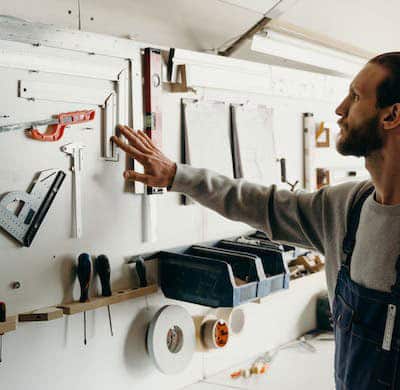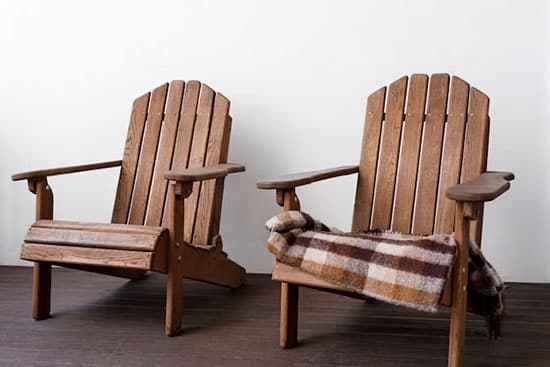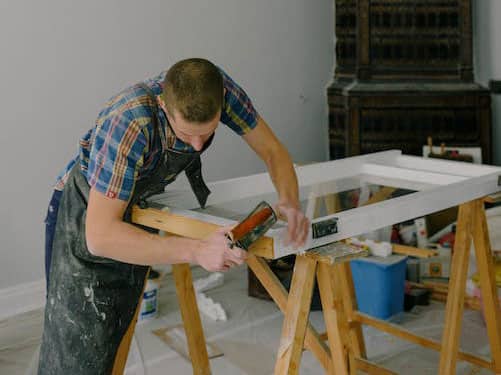All About Furniture Makeovers [+ 3 Step-by-Step Projects]
 If you’re tired of that old chair or table in your home, have you ever thought about doing a furniture makeover?
If you’re tired of that old chair or table in your home, have you ever thought about doing a furniture makeover?
Furniture makeovers are a way for you to breathe new life into old, forgotten, or damaged pieces. By repurposing and upcycling, you contribute to a more sustainable lifestyle and unlock your creative potential. You’ll be able to personalize your space, express your style, and save money!
On this page, we’ll walk through the process of transforming a piece of furniture into something new and exciting. We’ll cover:
- The tools and materials you’ll need
- Selecting the furniture
- Design and planning
- Preparing the furniture
- Techniques for furniture makeovers
- Finishing
- Troubleshooting common problems
- 3 step-by-step furniture makeover projects
Let’s start with a brief look at what you’ll need.
Essential Tools and Materials
 Furniture makeovers are fairly simple and won’t require a lot of specialized equipment.
Furniture makeovers are fairly simple and won’t require a lot of specialized equipment.
To begin, ensure you have safety gear, such as safety glasses, gloves, and a dust mask.
You’ll also need screwdrivers, both flathead and Phillips head in various sizes, as well as a claw hammer and pliers to assist with disassembly and other tasks. A utility knife is useful for cutting away fabric, foam, or removing old glue.
And to remove old finishes, use paint and varnish remover along with a scraper. Mark Meulebroeck with Redmiter Furniture recommends a chisel for scraping off old finish and glue. He’s found them to be more effective than wood and putty knives.
Sanding is an essential step in most furniture makeovers, so have various grits of sandpaper, a sanding block, or an electric sander on hand.
Wood filler will help with filling cracks or gouges, while wood glue can be used for reattaching loose joints or veneer. Clamps in different sizes will keep pieces together as the glue dries.
Before applying a finish, use a tack cloth to remove any dust and debris. Brushes or foam brushes will be needed to apply paint, stain, or clear finishes, and rags or disposable gloves can help with applying stain and general clean-up.
If your restoration project involves reupholstering, make sure to have upholstery tools such as a staple remover, webbing stretcher, upholstery hammer, and upholstery needles. You may also need to replace old fabric, foam, or padding with new materials.
Keep in mind that you may not need every tool or material listed here. It all depends on the project you’re doing, so focus on the tools and materials most appropriate to that.
For a comprehensive list of tools you may want to keep on hand, check out “The Ultimate Guide: 50 Must-Have Tools for the DIY Homeowner.” There, you’ll find a detailed breakdown of various hand and power tools to fully equip your toolbox for any home improvement project.
Selecting the Furniture Piece
 The piece of furniture you choose for a project involves many factors, including your own skills, the condition of the piece, and the style you’re going for. We’ll cover what you need to consider for each aspect:
The piece of furniture you choose for a project involves many factors, including your own skills, the condition of the piece, and the style you’re going for. We’ll cover what you need to consider for each aspect:
Assess your skills and project goals
Before taking on a complicated restoration, evaluate your skills, experience, and comfort level with various woodworking and finishing techniques. Set realistic project goals that align with your capabilities, whether it’s creating a statement piece, matching your current decor, or upcycling a functional item for daily use.
Also, how much time and resources do you have available? Are they enough to see the project through from start to finish? Don’t bite off more than you can chew if you’re new to furniture makeovers.
Evaluate furniture condition
Thoroughly examine the furniture for any signs of structural damage, such as loose or broken joints, wobbly legs, cracked or split wood, or water damage. If you identify any issues, are they something you can fix with your skillset and tools?
You may decide that the repairs aren’t worth the time and effort and that you’d rather choose a different piece.
Also, check the furniture’s surface for old finishes, paint, or varnish that may need to be removed before refinishing. Ensure the surface can be easily prepped for the new finish you have in mind.
Choose furniture styles and materials
Select a furniture piece with a style and material that align with your vision and can be easily adapted to your desired aesthetic. Solid wood furniture is generally more durable and easier to repair than particleboard or veneered items, making it a more suitable choice for most makeovers.
Ask yourself if the underlying piece is worth your investment, or if you should go look for another opportunity.
Where to find furniture pieces
If you don’t have a piece of furniture that you could use for a makeover, there are many other places to find one inexpensively, including:
- Thrift stores
- Garage sales
- Estate sales
- Online marketplaces
These venues often offer a wide range of styles and conditions at affordable prices. Be open-minded—even unassuming pieces can be transformed into woodworking masterpieces, as long as they’re good quality.
Design and Planning
Before you begin your project, you’ll want to have a good idea of what you plan to accomplish.
Sketch your design
Start by sketching the existing furniture piece, either by hand or using design software. This will provide a visual foundation for your makeover ideas.
And feel free to experiment! Overlay your design ideas onto the sketch, trying out different finishes, colors, and decorative elements. This process allows you to see how various options work together and helps refine your vision.
Choose colors and a finish
Select a color scheme that complements your design vision and existing decor. Consider factors such as room lighting, intended use, and desired mood when choosing colors.
Along with color, what kind of finish do you want for your furniture piece? Some options include paint, stain, varnish, and wax. Each finish has its own characteristics and application techniques, so research the best option for your desired look, skill level, and the material you’re working with. Our article on wood finishes can help you with that.
Incorporate decorative elements
Choose new knobs, handles, hinges, or other hardware that complement your design and enhance the furniture’s functionality.
Also consider adding trim, molding, or appliques to create visual interest and enhance the furniture’s style. For an extra touch, you could even use stencils or decals to add patterns, designs, or other decorative elements.
Set a timeline and budget
Determine a realistic timeline for completing your furniture makeover, taking into account factors such as drying times, the complexity of the project, and your available time. It’s always good to add about 50% more time than you think the project will take—this will give you some buffer.
Calculate the estimated cost of materials, tools, and any additional expenses for your project, too. Having a budget will guide you in your purchases and prevent overspending.
Finally, create a list that outlines each step of the makeover process, along with deadlines for completing each task. With a good plan, you’ll be ready to dive into your project.
Preparing the furniture piece
Once you’ve chosen a piece of furniture for a makeover, it’s time to prepare it. This process ensures that the final product is both functional and visually appealing. Follow these steps to prepare your furniture piece:
 Disassemble the furniture
Disassemble the furniture
Remove any hardware, such as knobs, handles, and hinges, to avoid damaging the furniture during the makeover process. Keep small parts organized by placing them in labeled containers.
If necessary, disassemble the furniture into smaller components, such as removing drawers or separating tabletops from bases. This step will make it easier to work on individual parts and access hard-to-reach areas.
Clean the furniture
Use a vacuum cleaner with a brush attachment or a soft brush to remove dirt and dust from the furniture’s surface and crevices.
Then, use a soft cloth or sponge to wipe down the furniture with a mild cleaner diluted in warm water.
Avoid soaking the wood, though, as this may cause damage. If the furniture has any MDF or particle-board, avoid using water near those sections.
Allow the piece to dry completely before moving on to the next step.
Repair structural damage
Inspect the furniture for loose or wobbly joints, and tighten any screws or fasteners as needed.
Also, replace or repair broken or damaged parts, such as cracked legs or split panels. Depending on the severity of the damage, you may need to use wood filler, epoxy, or replacement parts.
For more complex repairs, such as re-gluing or clamping joints, consult a woodworking guide or seek professional advice.
Sand and prep surfaces
Use a combination of chemical paint strippers, scrapers, and sandpaper to remove old paint, varnish, or other finishes from the furniture’s surface. Follow the manufacturer’s instructions for any chemical products, and work in a well-ventilated area.
Then, sand the surfaces further, as needed. Start with a coarse grit (e.g., 80–100 grit) and progressively work your way up to a fine grit (e.g., 220 grit). This process will remove any remaining finish and create a smooth, even surface for new paint or stain.
Once you’re finished sanding, remove dust with a tack cloth or damp rag.
If painting the furniture, apply a coat of primer to create a smooth, uniform base for the paint. Allow the primer to dry according to the manufacturer’s instructions before proceeding with the makeover. Be extremely thorough, or you’ll be paying for it later during finishing.
Next, let’s go over some common techniques you can use in your projects.
Techniques for Furniture Makeovers
There are various techniques you can employ to transform furniture pieces, depending on your skill level and desired outcome. Here’s a look at three main ones:
- Painting
- Reupholstering
- Refinishing
Remember to practice new techniques on scrap material before applying them to your furniture. That way, you won’t have any surprises!
Painting
- Distressing: This technique involves intentionally adding wear and tear to a painted
surface to create an aged, vintage look. Use sandpaper, steel wool, or specialized tools to remove some of the paint, focusing on areas that would naturally see more wear, such as edges and corners. - Glazing: Apply a tinted glaze over a painted surface to create depth and dimension. This technique enhances details and textures, resulting in an antiqued or weathered appearance.
- Dry brushing: Lightly apply paint to the surface with a dry brush, creating subtle color variations and a textured appearance. This technique is ideal for highlighting details and adding visual interest.
- Stenciling: Use pre-made or custom stencils to add patterns, designs, or decorative elements to your furniture piece. This technique can be used with paint or other materials like gold leaf or wood stain.
Reupholstering
Replace worn-out fabric, padding, or springs on upholstered furniture to give it a fresh look. Choose a new fabric that fits with your design vision and enhances the furniture’s comfort and functionality.
Refinishing
Strip off the old finish from your furniture and apply a new coat of paint, stain, varnish, or whatever you decide is a good fit. Refinishing can significantly change the appearance of a piece and protect the surface from wear and tear.
Finishing Touches
The final step in a furniture makeover involves adding protective finishes, reassembling the piece, and styling it to showcase its full potential. These finishing touches ensure that your masterpiece is not only visually appealing but also durable and functional.
Here’s a more detailed breakdown of this stage:
Protective finishes
A protective finish is crucial to preserving the longevity of your refurbished furniture. It safeguards the surface from wear and tear, scratches, and other damage, while also enhancing its appearance.
Choose from a variety of finishes, such as:
- Wax: Furniture wax provides a natural, low-sheen finish and is ideal for chalk or milk-painted surfaces. It adds a subtle luster while providing a layer of protection.
- Polyurethane: This popular finish comes in various sheens, from matte to high gloss. It’s highly durable, water-resistant, and suitable for surfaces that will see heavy use, such as tabletops.
- Water-based polyurethane: As the name indicates, this one is a water-based alternative to polyurethane. It’s easy to apply and clean up, with low odor and a quick drying time. It works well for light-colored surfaces, as it doesn’t yellow over time.
- Hardwax oil finish: This type of finish is a mixture of oil and wax that is extremely easy for beginners to use. You don’t have to be skilled at brushing finishes or have certain spray equipment on hand. All you have to do is apply the finish and then wipe it. The only downside is that it isn’t quite as durable as some of the other options.
Reassembling furniture
Carefully put your furniture back together, making sure all the components are secure and properly aligned.
If you disassembled the piece during the makeover process, use this opportunity to replace any damaged or worn-out hardware with new, updated pieces. New hardware, like knobs and handles, can significantly change the overall look of your furniture.
Styling and staging
Finally, present your refurbished furniture in a way that highlights its unique features and complements the surrounding décor. Consider the following tips for styling and staging your masterpiece:
- Placement: Position the furniture in a spot that showcases its beauty and allows for easy access. Ensure that it doesn’t obstruct walkways or create visual clutter.
- Accessories: Add decorative elements like throw pillows, blankets, or tabletop accessories that complement the piece’s color and style. Be mindful not to overdo it—less is often more when it comes to accessorizing.
- Lighting: Ensure that the area around the furniture is well-lit, using natural light, floor lamps, or table lamps. Good lighting will accentuate the piece’s design details and make it an inviting focal point in the room.
Troubleshooting and Common Mistakes
During a furniture makeover, you may encounter issues that need to be addressed. Here are some common problems and their solutions:
Paint and finish problems
- Drips and brush marks: To prevent drips and brush marks, use a high-quality brush or foam roller and apply thin, even coats of paint. If you notice drips or marks after painting, sand them lightly and apply another coat of paint.
- Uneven stain: To avoid uneven staining, sand the wood evenly and apply a pre-stain conditioner. Apply the stain using a brush or rag, working in the direction of the wood grain. Wipe off any excess with a clean cloth and allow it to dry before applying additional coats or a protective finish.
Structural issues
- Loose joints: If you find a loose or wobbly joint during your makeover, disassemble the joint and clean off any old glue or debris. Apply fresh wood glue and clamp the joint together until the glue dries.
- Broken components: Repair or replace damaged parts, such as cracked legs or split panels. Depending on the severity of the damage, use wood filler, epoxy, or replacement parts to restore the piece’s structural integrity.
Uneven Surfaces and Gaps
- Surface imperfections: Fill small dents, scratches, or holes with wood filler, and sand the surface smooth. If there are larger imperfections, consider using epoxy or other repair materials to rebuild the damaged area.
- Gaps or open joints: If you notice gaps or open joints in your furniture piece, fill them with wood filler or putty. Sand the filled areas smooth and ensure they are level with the surrounding surface before applying paint or finish.
By addressing these common issues during your furniture makeover, you can ensure a polished final product that looks professional and well-crafted.
3 Step-by-Step Furniture Makeover Projects
When it comes to furniture makeovers, you have so many options to choose from! Here are three ideas to get your creative juices flowing:
 Transforming a dresser into a kitchen island
Transforming a dresser into a kitchen island
Materials:
- An old dresser
- Sandpaper (80 and 220 grit) or electric sander
- Wood filler (if necessary)
- Tack cloth
- Primer (appropriate for wood)
- Paint (semi-gloss or satin finish)
- Clear polyurethane or lacquer (optional)
- Paintbrushes or paint rollers
- New cabinet pulls or knobs
- Casters (optional)
- Countertop material (such as wood, granite, or butcher block)
- Construction adhesive (for countertop)
Steps:
- Remove all hardware and drawers from the dresser. If there are any holes or gaps, fill them with wood filler and let it dry.
- Sand the dresser with 80-grit sandpaper to remove old paint, varnish, or rough spots. Follow up with 220-grit sandpaper for a smooth finish.
- Wipe the dresser with a tack cloth to remove dust.
- Apply a coat of primer to the dresser, following the manufacturer’s instructions for drying time.
- Paint the dresser using a semi-gloss or satin finish paint. Apply multiple coats, allowing each coat to dry before applying the next.
- For added durability, apply a clear coat of polyurethane or lacquer and let it dry.
- Attach new cabinet pulls or knobs to the dresser.
- If desired, attach casters to the bottom of the dresser for mobility.
- Measure and cut the countertop material to fit the dresser’s top. Apply construction adhesive to the dresser’s top, and carefully place the countertop on it.
- Apply pressure and let the adhesive dry according to the manufacturer’s instructions.
Upcycling a bookcase into a stylish bar cart
Materials:
- An old bookcase (preferably with wheels or casters)
- Sandpaper (80 and 220 grit) or electric sander
- Wood filler (if necessary)
- Tack cloth
- Primer (appropriate for wood)
- Paint (semi-gloss or satin finish)
- Clear polyurethane or lacquer (optional)
- Paintbrushes or paint rollers
- Casters (if not already attached)
- Screws and screwdriver
- Wine glass racks (optional)
- Additional shelving or storage solutions (optional)
Steps:
- Remove any hardware, shelves, or other removable parts from the bookcase.
- Fill any holes or gaps with wood filler, and let it dry.
- Sand the bookcase with 80-grit sandpaper to remove old paint or varnish, followed by 220-grit sandpaper for a smooth finish.
- Wipe the bookcase with a tack cloth to remove dust.
- Apply primer to the bookcase, following the manufacturer’s instructions for drying time.
- Paint the bookcase with a semi-gloss or satin finish paint. Apply multiple coats, allowing each coat to dry before applying the next.
- For added durability, apply a clear coat of polyurethane or lacquer and let it dry.
- Reassemble the bookcase, adding any additional shelving or storage solutions as desired.
- If the bookcase does not already have wheels or casters, attach them to the bottom for mobility.
- Optionally, install wine glass racks on the underside of one of the shelves for additional storage.
Repurposing a chair into a unique planter
 Materials:
Materials:
- An old chair
- Sandpaper (80 and 220 grit) or electric sander
- Wood filler (if necessary)
- Tack cloth
- Primer (appropriate for wood)
- Paint (semi-gloss or satin finish)
- Clear polyurethane or lacquer (optional)
- Paintbrushes or paint rollers
- A container or pot to hold the plant (with a diameter smaller than the chair seat)
- Potting soil
- Plants of your choice
- A drill with a hole saw attachment (optional)
- Jigsaw (optional)
Steps:
- Remove any cushions, upholstery, or other removable parts from the chair.
- Fill any holes or gaps with wood filler, and let it dry.
- Sand the chair with 80-grit sandpaper to remove old paint or varnish, followed by 220-grit sandpaper for a smooth finish.
- Wipe the chair with a tack cloth to remove dust.
- Apply primer to the chair, following the manufacturer’s instructions for drying time.
- Paint the chair with a semi-gloss or satin finish paint. Apply multiple coats, allowing each coat to dry before applying the next.
- For added durability, apply a clear coat of polyurethane or lacquer and let it dry.
- Measure the diameter of your container or pot. If the chair seat is solid, use a drill with a hole saw attachment to create a hole in the center of the seat, slightly smaller than the diameter of the container or pot.
- Alternatively, if the chair seat is not solid or you want a larger planting area, use a jigsaw to cut out a hole in the chair seat, large enough to accommodate the container or pot, but leaving enough edge to support the container or pot.
- Place the container or pot into the hole, ensuring a snug fit.
- Fill the container or pot with potting soil and plant your choice of flowers, herbs, or greenery.
With a little imagination and some basic tools and materials, you can give new life to old furniture and create unique, functional, and stylish additions to your home.
Protect Your Furniture Makeovers from Moisture
Furniture makeovers are eco-friendly and cost-effective. But more than that, they allow you to be creative with your own style. You can take a piece and personalize it to your heart’s content!
If you’re new to these types of projects, be sure to give yourself some grace. You may face some challenges, but each of them will be an opportunity to learn new techniques and tricks.
There is one challenge, though, that you can avoid—and that’s the challenge of moisture. Use a wood moisture meter to check your wood furniture’s moisture content before you begin working with it so that excess moisture doesn’t ruin your hard work.
To learn more about controlling moisture with furniture and other wood projects, see our article on the correct moisture content for woodworking.

Wagner Meters is a family-owned American business that aims to provide solutions in moisture measurement technology that will enhance the quality and value of each customer’s project. With an almost 60-year legacy of innovation, Wagner continues to be a resource for both individual craftsmen and high-performance commercial endeavors.
Last updated on March 17th, 2025



